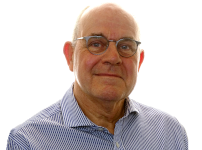

Simon Bartle, Visual Arts Correspondent
Alan Davie And David Hockney: Early Works At The Hepworth, Wakefield


What convergence does the exhibition celebrate? The answer is the meeting of two great talents through the medium of Alan Davie's first retrospective exhibition in 1958, at the former Wakefield Art Gallery. At that exhibition a young David Hockney saw both Alan's work, and heard him talking about his art. It was a life changing moment for Hockney. Shortly after the exhibition, Hockney took up a place at the Royal College of Art in London, where he moved away from figurative painting. Thereafter, he followed in the footsteps of Davie as he too adopted a colourful abstract style shaped by passion, poetry and symbolism. Hockney moved between figurative and abstract painting, but the purely figurative mould had been broken, and a new imaginative, innovative artist had been unleashed.
Davie's large scale painting Creation of Man (1957), featured in the 1958 exhibition, and is on show again in this exhibition, and it has not lost any of its visual impact. At 3 metres in length you will not miss it. It was the centrepiece in 1958, and it is again on this occasion. Its undeniable quality has certainly stood the test of time.

Thereafter, did Davie and Hockney follow parallel paths? That is for you to decide, and this exhibition provides you with the opportunity to compare, and contrast their early works. Certainly their works are distinctive, and yes they both appeared in films, and on television. The similarities do not end there. Both artists featured regularly in the Sunday Supplement Magazines, and were no strangers to publicity. So in those respects their paths were similar, but not unique, as other contemporary artists received the same media treatment. This was the era of the Pop Artist, and whether or not, you identified with that 'brand' you were unwittingly part of that 'circus'.
So the viewer needs to cast their net wider in the quest for convergent paths. The answer is not far away. There are thematic crossovers of love, poetry and passion. The exhibition explores all these influences, and for good measure introduces us to their central theme of 'hinted symbolism'. Davie and Hockney successfully experimented, and tested new painting surfaces. They were both undoubtedly innovators, and in essence explorers in a new world of art with diminishing boundaries. They tested those limits, and pushed back the barriers.

Also by Simon Bartle...
Pre-Raphaelite Knights: Reinventing The Medieval World At The Bowes MuseumBill Brandt And Henry Moore: At The Hepworth, WakefieldTurner: Northern Exposure At The Mercer Art Gallery, HarrogateDora Maar: Tate ModernNorman Cornish: The Definitive Collection At The Bowes Museum, Co DurhamYou may possibly arrive at a considered judgement, which says that it is all three, and you would not be wrong.
Finally, before we leave the theme of convergences, as you walk around the other galleries at the Hepworth, you cannot help but stumble across another convergence, but that's another story, for another occasion.
The Hepworth Wakefield's exhibition programme is supported by Hiscox, The Contemporary Circle and Alan Wheatley Art
The Hepworth Wakefield, Gallery Walk, Wakefield, West Yorkshire, WF1 5AW
Open daily, 10am – 5pm. Free entry
https://hepworthwakefield.org/your-visit/